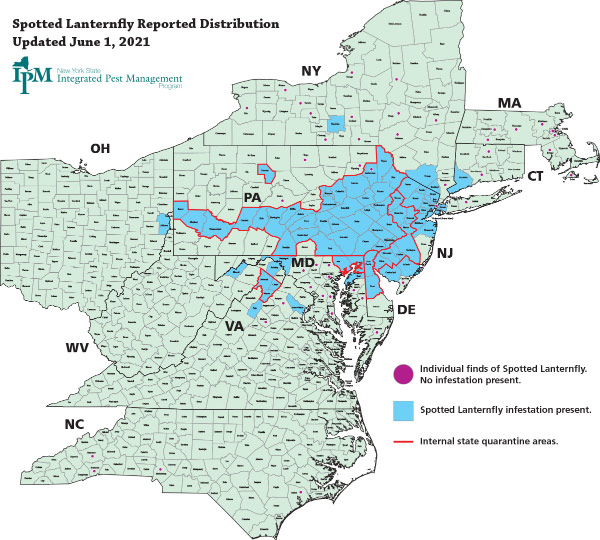Spotted Lanternfly Updates
 |
By Nancy Cusumano
Although efforts to develop management techniques to control the invasive spotted lanternfly (SLF) are well underway—including current work funded by a USDA Specialty Crop Research Initiative grant awarded in 2019—as expected, the pest’s presence and influence have continued to spread.
Since fall of 2020, there have been a number of finds—not always indicating established populations, but generally illustrating the pest’s penchant for spreading, particularly with inadvertent human assistance.
Recent Timeline
October 2020
Last October, two dead SLF individuals were found in Massachusetts and egg masses were found in Maine. Both had been transported in on plant material that originated in Pennsylvania. The egg masses were empty and presumably had hatched in Pennsylvania, not in Maine.
Live populations were discovered in New Canaan and Greenwich, Connecticut, and in Jefferson County, Ohio, along the Ohio River and adjacent to the known western Pennsylvania population in Beaver County.
The SLF map maintained by the New York State IPM Program was updated to reflect infestations in these Connecticut and Ohio counties, in addition to Washington County in Maryland.
November 2020
In November, a population was discovered in Ithaca, NY, by an entomology undergraduate student. Adults and egg masses were discovered around the parking area of a student apartment complex. Once 2021 arrived, a springtime removal of trees in the vicinity was conducted to stop any undiscovered egg masses from hatching.
Dead adults were found in Michigan, but there remain no known live populations. The dead adults arrived on freight or trucks from infested areas.
In New York, large infestations were found in Orangeburg, Port Jervis, and Staten Island.
The map was updated to include Tompkins, Orange, and Rockland Counties, as well as Staten Island, Brooklyn, and Queens in the New York metropolitan area. Also added was Mineral County in West Virginia.
Also this month, Brian Walsh, a Penn State Extension horticulture educator in Berks County, PA, presented a webinar—Spotted Lanternfly: Impacts and Strategies for Ornamental Plants—a useful overview of this pest and its implications. Visit www.hriresearch.org/thrive-web-series to view this and other webinars in the Horticultural Research Institute tHRIve web series.
January 2021
Berkley County, in western Maryland, was added to the map. There also were dead individuals discovered in three North Carolina counties.
February 2021
In February, Virginia expanded its quarantine area by two more counties, Warren and Clarke.
Several New Jersey counties were added to the map, reflecting that most of the state is now infested.
March 2021
Pennsylvania added eight more counties to its quarantine, painting a swath westward across the whole state. The counties added were Cambria, Cameron, Franklin, Lackawanna, Montour, Pike, Wayne, and Westmoreland. These counties are not completely infested but have some municipalities with known infestations.
The 2021 Spotted Lanternfly Summit was held virtually over the course of three full days, featuring presentations on new research, extension, and communications efforts and outreach to stakeholders and industry.
Visit StopSLF.org to watch the summit presentations. Also available to view is the recording of Spotted Lanternfly 101, a presentation and Q&A session held the week before the summit and intended to provide attendees with foundational SLF knowledge key to deriving maximum benefit from the summit.
Resources
Stop SLF (www.stopslf.org)—The USDA SCRI-funded project to research and develop control methods for spotted lanternfly, maintained by the Northeastern IPM Center.
Penn State Extension: Spotted Lanternfly (extension.psu.edu/spotted-lanternfly)—Penn State was the lead institution on the 2018 Northeastern IPM Center-funded working group that laid the groundwork for the USDA SCRI grant, and the grant’s project director, Julie Urban, is an associate research professor at Penn State.
The Northeastern IPM Center promotes integrated pest management for reducing risks to human health and the environment. If republishing our news, please acknowledge the source (“From Northeast IPM Insights”) along with a link to our website.
